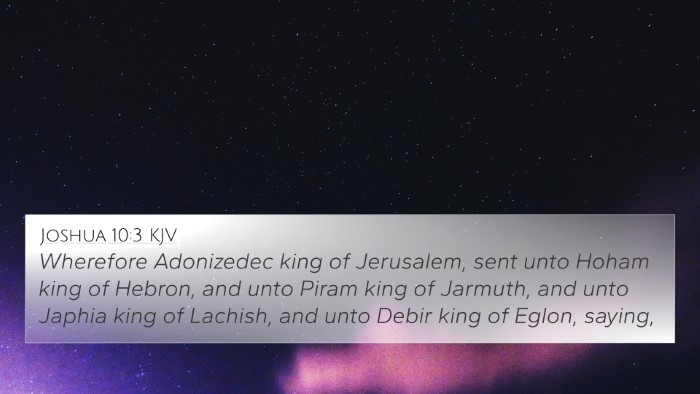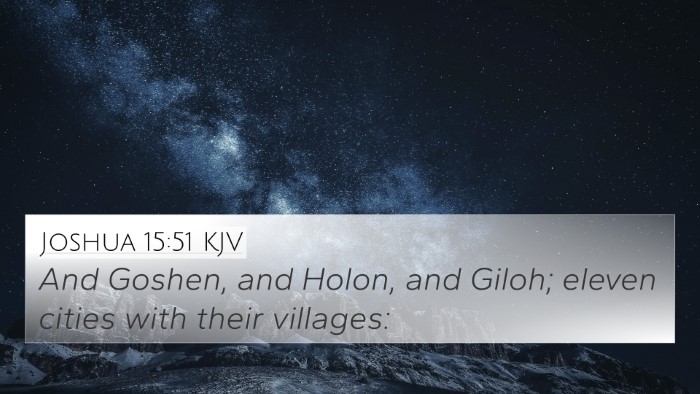Understanding 1 Chronicles 6:58
Verse Reference: 1 Chronicles 6:58 states, "And H settlement was in the village of H, with other cities of the regions." This verse is part of a listing of Levitical cities, emphasizing the importance of specific locations given to the Levites for their service.
Contextual Overview
The Book of Chronicles focuses on the history of Israel from a priestly perspective, highlighting the roles of the Levites and the importance of worship in the temple. This verse shows a continuation of the genealogical and geographical emphasis seen throughout the book, particularly related to the responsibilities of the Levites.
Commentary Highlights
- Matthew Henry: Henry notes that the cities assigned to the Levites represent their role in maintaining sacred duties and their vital connection to the worship of God. The delineation of these towns underscores God’s provision for the Levites in fulfilling their priestly vocation.
- Albert Barnes: Barnes emphasizes the significance of the cities’ locations in relation to the overall structure of Israelite society, asserting that the Levitical cities served as a necessary means for the Levites to fulfill their obligations while being integrated into the community.
- Adam Clarke: Clarke highlights the practical implications of this verse, focusing on the importance of designated areas for religious leaders. He discusses how these cities became centers of spiritual guidance and instruction within the Israelite community.
Thematic Connections
This verse is interconnected with various themes in the Bible, particularly regarding land ownership, priestly duties, and community support. It offers insights into the responsibilities ordained by God for the Levites and the importance of designated places for spiritual leaders.
Bible Verse Cross-References
For a deeper understanding, here are several Bible verses that echo the themes present in 1 Chronicles 6:58:
- Numbers 35:2-8: This passage outlines the appointment of cities for the Levites, echoing the emphasis on designated locations for their service.
- Joshua 21:2-3: Joshua’s distribution of cities confirms the continued acknowledgment of the Levites’ role in serving the community.
- Deuteronomy 18:6-8: This verse discusses the Levites’ entitlement to share in the offerings, showcasing their dependence on the community.
- Hebrews 7:14: This New Testament reference relates to the priestly order, drawing connections between the Old and New Testament understandings of priesthood.
- 1 Peter 2:9: Peter refers to believers as a royal priesthood, connecting the identity of the Levites to the church today.
- Malachi 2:7: Malachi addresses the role of priests in teaching and preserving knowledge, a reflection of the responsibilities indicated in Chronicles.
- Jeremiah 33:18: This verse reiterates God’s promise regarding the Levitical priesthood, affirming the ongoing significance of their role.
- Luke 10:1-2: Jesus sends out His disciples in a manner similar to how Levites were appointed, highlighting the continuity of ministry roles.
- Acts 6:4: The apostles focused on prayer and ministry of the word, paralleling the Levites' dedication to God’s service.
- Revelation 1:6: Believers being made a kingdom of priests ties back to the Levitical role established in the Old Testament.
Practical Applications
The understanding of 1 Chronicles 6:58 is significant for modern readers in several ways:
- Guidance for Church Leadership: Just as the Levites were given specific cities to serve, church leaders today are called to specific responsibilities within their communities.
- Community Integration: The Levites' cities emphasize the need for spiritual leaders to be woven into the fabric of their communities, creating a relationship of mutual support.
- Understanding of Provision: God’s provision for the Levites serves as a reminder that He cares for His servants and will provide for their needs through the giving of the community.
Conclusion
In summary, 1 Chronicles 6:58 serves as a poignant reminder of the significance of the Levitical order and their designated roles within Israel's spiritual framework. By exploring the links between this verse and others in scripture, one can appreciate the continuity of God's covenant and provision throughout biblical history.
Further Study and Tools
For those interested in exploring the interconnected themes in the Bible, consider utilizing the following resources:
- Bible concordance
- Cross-reference Bible study guides
- Bible chain references
- Comparative Bible verse analysis tools








